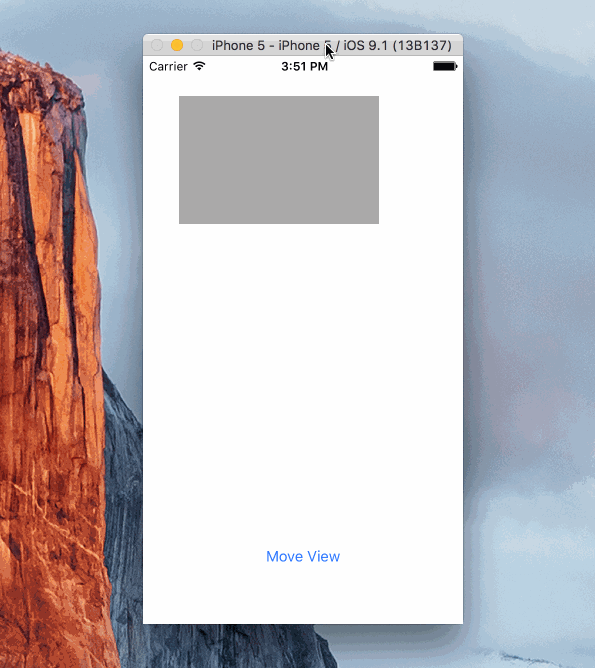How do I animate constraint changes?
Generally, you just need to update constraints and call layoutIfNeeded inside the animation block. This can be either changing the .constant property of an NSLayoutConstraint, adding remove constraints (iOS 7), or changing the .active property of constraints (iOS 8 & 9).
Sample Code:
[UIView animateWithDuration:0.3 animations:^{
// Move to right
self.leadingConstraint.active = false;
self.trailingConstraint.active = true;
// Move to bottom
self.topConstraint.active = false;
self.bottomConstraint.active = true;
// Make the animation happen
[self.view setNeedsLayout];
[self.view layoutIfNeeded];
}];
Sample Setup:

Controversy
There are some questions about whether the constraint should be changed before the animation block, or inside it (see previous answers).
The following is a Twitter conversation between Martin Pilkington who teaches iOS, and Ken Ferry who wrote Auto Layout. Ken explains that though changing constants outside of the animation block may currently work, it's not safe and they should really be change inside the animation block. https://twitter.com/kongtomorrow/status/440627401018466305
Animation:

Sample Project
Here's a simple project showing how a view can be animated. It's using Objective C and animates the view by changing the .active property of several constraints.
https://github.com/shepting/SampleAutoLayoutAnimation
I appreciate the answer provided, but I think it would be nice to take it a bit further.
The basic block animation from the documentation
[containerView layoutIfNeeded]; // Ensures that all pending layout operations have been completed
[UIView animateWithDuration:1.0 animations:^{
// Make all constraint changes here
[containerView layoutIfNeeded]; // Forces the layout of the subtree animation block and then captures all of the frame changes
}];
but really this is a very simplistic scenario. What if I want to animate subview constraints via the updateConstraints method?
An animation block that calls the subviews updateConstraints method
[self.view layoutIfNeeded];
[self.subView setNeedsUpdateConstraints];
[self.subView updateConstraintsIfNeeded];
[UIView animateWithDuration:1.0f delay:0.0f options:UIViewAnimationOptionLayoutSubviews animations:^{
[self.view layoutIfNeeded];
} completion:nil];
The updateConstraints method is overridden in the UIView subclass and must call super at the end of the method.
- (void)updateConstraints
{
// Update some constraints
[super updateConstraints];
}
The AutoLayout Guide leaves much to be desired but it is worth reading. I myself am using this as part of a UISwitch that toggles a subview with a pair of UITextFields with a simple and subtle collapse animation (0.2 seconds long). The constraints for the subview are being handled in the UIView subclasses updateConstraints methods as described above.
// Step 1, update your constraint
self.myOutletToConstraint.constant = 50; // New height (for example)
// Step 2, trigger animation
[UIView animateWithDuration:2.0 animations:^{
// Step 3, call layoutIfNeeded on your animated view's parent
[self.view layoutIfNeeded];
}];
Two important notes:
You need to call
layoutIfNeededwithin the animation block. Apple actually recommends you call it once before the animation block to ensure that all pending layout operations have been completedYou need to call it specifically on the parent view (e.g.
self.view), not the child view that has the constraints attached to it. Doing so will update all constrained views, including animating other views that might be constrained to the view that you changed the constraint of (e.g. View B is attached to the bottom of View A and you just changed View A's top offset and you want View B to animate with it)
Try this:
Objective-C
- (void)moveBannerOffScreen {
[self.view layoutIfNeeded];
[UIView animateWithDuration:5
animations:^{
self._addBannerDistanceFromBottomConstraint.constant = -32;
[self.view layoutIfNeeded]; // Called on parent view
}];
bannerIsVisible = FALSE;
}
- (void)moveBannerOnScreen {
[self.view layoutIfNeeded];
[UIView animateWithDuration:5
animations:^{
self._addBannerDistanceFromBottomConstraint.constant = 0;
[self.view layoutIfNeeded]; // Called on parent view
}];
bannerIsVisible = TRUE;
}
Swift 3
UIView.animate(withDuration: 5) {
self._addBannerDistanceFromBottomConstraint.constant = 0
self.view.layoutIfNeeded()
}